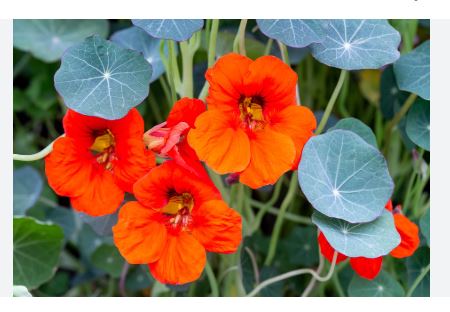
The nasturtium, known scientifically as Tropaeolum majus, belongs to the botanical family Tropaeolaceae. This genus, Tropaeolum, is named for its shield-shaped leaves, reminiscent of ancient Roman trophies, from which it derives its name – ‘tropaeum’ in Latin. The plant features vibrant, often intensely colored flowers with five petals and a unique nectar spur. It’s classified as an herbaceous perennial in its native habitats but is commonly grown as an annual in many regions due to its sensitivity to frost.
The history of the nasturtium is as colorful as its flowers. Originating from the Andes of South America, it was first introduced to Europe by Spanish conquistadors in the 16th century. Initially brought back as a culinary herb, its peppery leaves and flowers were likened to watercress, hence the common name “nasturtium” which translates from Latin as “nose-twister” due to its spicy flavor. By the 18th century, nasturtiums had become popular not only for their taste but also for their ornamental value, appearing in the gardens of nobility and historical figures like Thomas Jefferson at Monticello. Over centuries, various species and hybrids have been developed, enhancing the plant’s diversity in form and color.
Nasturtiums are native to South and Central America, particularly thriving in the regions from Mexico down to Chile. In their natural environment, they grow in the understory of montane forests, at elevations where their climbing or sprawling habit can be supported by the surrounding vegetation.
When it comes to USDA hardiness zones, nasturtiums are considered tender perennials in zones 9 to 11, where they can survive mild winters. However, in cooler climates, they are generally treated as annuals, as they do not withstand frost well. This adaptability has made them a favorite in gardens worldwide, where they’re appreciated for their ease of growth, bright blooms, and the ability to thrive even in poor soil conditions, marking them as both an ornamental and a practical garden plant.
Nasturtium Flower: Characteristics
- Flower Shape and Structure: Nasturtium flowers have a distinctive shape with five petals; one large, spurred petal at the back and four smaller petals around the center. The spur, which extends from the back of the flower, contains nectar and is a key feature for identification.
- Color Varieties: Nasturtium flowers come in a wide array of colors including vibrant yellows, oranges, reds, and even some with variegated or bicolored petals. The intensity and shade can vary, but they’re known for their bright, bold hues.
- Leaf Shape: The leaves of nasturtiums are also quite distinctive, being nearly circular with a deep central notch, giving them a shield-like appearance. They are often described as water lily-shaped, with a smooth, slightly waxy texture.
- Growth Habit: Depending on the variety, nasturtiums can either trail or climb. Trailing types spread out along the ground or over containers, while climbing varieties can ascend with the help of supports, using their stems to coil around.
- Flower Size: The flowers are relatively large for an annual, typically ranging from 2 to 3 inches across, making them quite noticeable in any garden setting.
- Fragrance: Nasturtium flowers have a subtle, somewhat spicy fragrance, which can be detected when you get close to them or when they are in full bloom in a concentrated area.
- Edible Parts: Both the flowers and the leaves have a peppery taste, much like watercress. This is a unique characteristic among ornamental plants, as all parts of the nasturtium (flowers, leaves, and seeds) are edible, contributing to its identification in culinary gardens.
Nasturtium Flower: Cultivation
Planting Time
Sow nasturtium seeds directly into the garden after the last frost when the soil has warmed up, typically in late spring or early summer. They don’t transplant well, so avoid starting them indoors.
Soil Requirements
Nasturtiums prefer well-drained, not overly fertile soil. In fact, too rich a soil can lead to more foliage than flowers. A sandy or loamy soil works best.
Sunlight
They thrive in full sun but can tolerate partial shade, especially in hotter climates where afternoon shade can prevent scorching.
Watering
Water moderately; nasturtiums are somewhat drought-tolerant once established but benefit from consistent moisture, especially when young or in bloom. Avoid overwatering to prevent rot.
Spacing
Space seeds or seedlings about 8 to 12 inches apart to allow for growth and air circulation, which helps prevent disease.
Support for Climbers
For climbing varieties, provide trellises, fences, or other supports for the vines to climb. Trailing types can be allowed to sprawl or can be directed over low supports.
Fertilization
Nasturtiums do not require much fertilization; too much can lead to lush foliage at the expense of flowers. If fertilizing, use a light, balanced fertilizer sparingly.
Pest Control
Nasturtiums can act as a natural pest deterrent for other plants, particularly against aphids. However, they might attract caterpillars or caterpillar-like beetles in some areas. Manual removal is often effective.
Deadheading
Remove spent flowers to encourage more blooms. This also keeps the plant looking tidy and prevents self-seeding if you want to control where nasturtiums grow next season.
Harvesting
For culinary use, pick flowers, leaves, and seed pods when they are at their peak. Flowers should be harvested in the morning when they are most hydrated.
Self-Seeding
Nasturtiums can self-seed prolifically if you allow some flowers to go to seed. This can be advantageous for a natural look but might require thinning out in subsequent years.
Winter Care
In zones where they’re not hardy (below USDA zone 9), treat nasturtiums as annuals. In warmer zones, they can be perennial but might need protection from severe cold snaps, or you can collect seeds for next year’s planting.